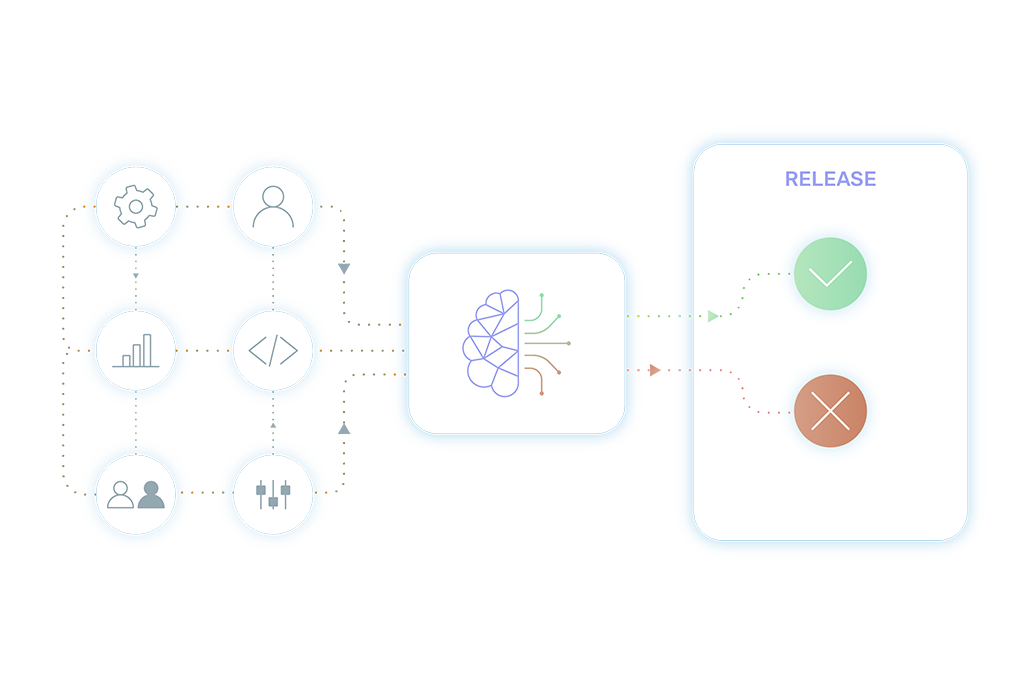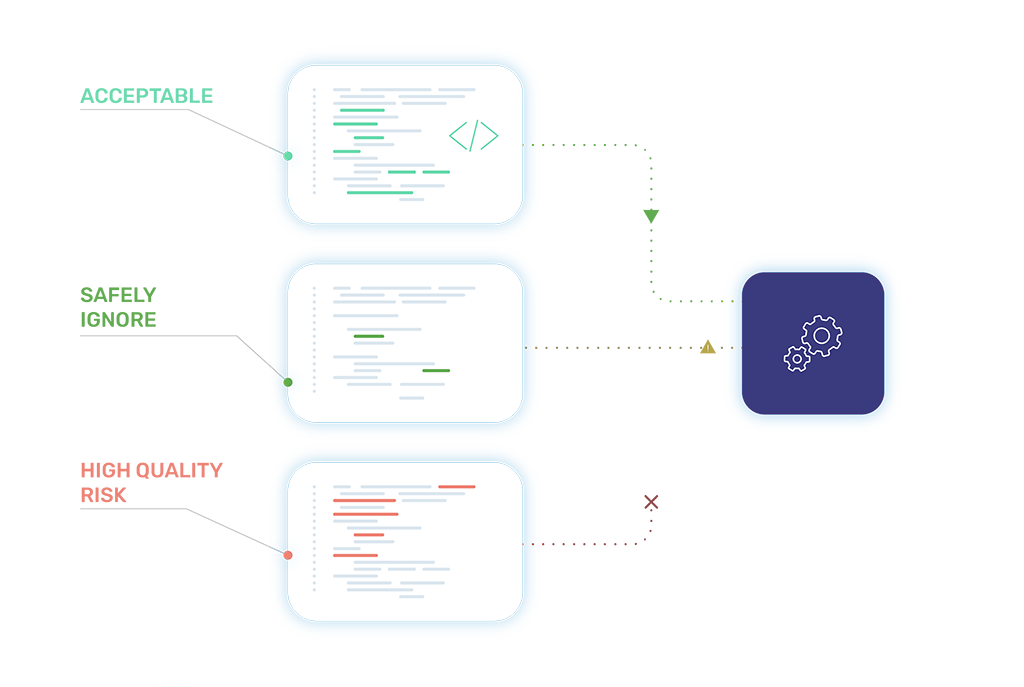In Today’s Hyper-Complex Environment, Can Quality Owners Guarantee High Software Quality?
In today’s fast-paced, hyper-complex development environment, software quality is becoming difficult, if not impossible, to control. Nobody in the enterprise—from top management to quality owners and individual QA teams—can really guarantee products will ship with high quality.
In most organizations, quality owners do not have the data needed to identify product quality at every stage of the SDLC. This data is simply not available or is not actionable in a fast-paced agile development environment. Gaps in testing efforts lead to declining quality; poor quality leads to customer dissatisfaction, and can even directly impact company revenues.
Quality owners can be the main force in solving this problem, but they need help. With the right tooling providing data about quality risks at every stage of the development pipeline, they can focus their quality efforts to ensure even the most complex development projects move to production with zero defect
In Today’s Hyper-Complex Environment, Can Quality Owners Guarantee High Software Quality?
In today’s fast-paced, hyper-complex development environment, software quality is becoming difficult, if not impossible, to control. Nobody in the enterprise—from top management to quality owners and individual QA teams—can really guarantee products will ship with high quality.
In most organizations, quality owners do not have the data needed to identify product quality at every stage of the SDLC. This data is simply not available or is not actionable in a fast-paced agile development environment. Gaps in testing efforts lead to declining quality; poor quality leads to customer dissatisfaction, and can even directly impact company revenues.
Quality owners can be the main force in solving this problem, but they need help. With the right tooling providing data about quality risks at every stage of the development pipeline, they can focus their quality efforts to ensure even the most complex development projects move to production with zero defect
Key Challenges of Software Quality Owners.
Software quality owners face the following key challenges with respect to managing and improving software quality in high-velocity development environments:
Key Challenges of Software Quality Owners.
Software quality owners face the following key challenges with respect to managing and improving software quality in high-velocity development environments:
 Increase Quality in Fast CI/CD Pipelines .
Increase Quality in Fast CI/CD Pipelines .
Quality owners need to track a huge number of code changes across multiple development pipelines and correlate them with thousands of manual and automated tests, to ensure all the relevant changes are properly tested. This is simply impossible to do manually.
 Traceability of Quality Risks from Planning to Production .
Traceability of Quality Risks from Planning to Production .
Quality owners must have a way to trace any software change, from the sprint planning and requirements stage, all the way to production. This would allow them to identify and remediate quality risks as soon as they enter the pipeline.
 Data-Driven Quality Standards .
Data-Driven Quality Standards .
Is a specific build good enough to be promoted further in the pipeline, or are more tests needed? Instead of making educated guesses, quality owners need hard data to understand the quality of a build and what quality efforts are needed to improve it.
 Automated, Smart Quality Gates.
Automated, Smart Quality Gates.
Quality owners spend a lot of their time evaluating release candidates but are still unable to check all untested code changes. What is needed is an automated quality gate that can identify critical untested changes, and block artifacts from being promoted to production.
 Smart Test Development Planning.
Smart Test Development Planning.
Testers and developers spend much of their time developing automated tests but are still unaware of which tests have the biggest impact on quality. Quality owners need this data to plan test development and make the most of testing resources.
 Increase Test Efficiency and Quality.
Increase Test Efficiency and Quality.
Quality owners need to know which parts of a software product are not sufficiently tested, either because tests are missing, or because existing tests are overlapping, redundant, or flaky. Focusing on known Test Gaps can dramatically increase the efficiency of new tests, and ensure that tests really improve product quality.
SeaLights Software Quality Governance.
SeaLights Software Quality Governance is the only solution that can help software development executives automatically identify, manage, and control every perceivable quality risk across the entire end-to-end delivery pipeline, for every single software change.
SeaLights Software Quality Governance.
SeaLights Software Quality Governance is the only solution that can help software development executives automatically identify, manage, and control every perceivable quality risk across the entire end-to-end delivery pipeline, for every single software change.
Risk Analysis of Every Change in Every Build.
Quality owners need central control of builds to truly control quality. Modern development teams run numerous builds every day; some are good candidates for promotion, while others have severe quality issues.
SeaLights Quality Governance leverages big data and the power of AI/ML to analyze every change in every build, giving executives and teams clear metrics about quality risks. When a build introduces a quality risk, engineering teams automatically receive feedback and can immediately resolve the problem. High-quality builds can be confidently promoted in the pipeline.

Risk Analysis of Every Change in Every Build.

Quality owners need central control of builds to truly control quality. Modern development teams run numerous builds every day; some are good candidates for promotion, while others have severe quality issues.
SeaLights Quality Governance leverages big data and the power of AI/ML to analyze every change in every build, giving executives and teams clear metrics about quality risks. When a build introduces a quality risk, engineering teams automatically receive feedback and can immediately resolve the problem. High-quality builds can be confidently promoted in the pipeline.

Analyzing Quality Risks in Real-Time.
Quality owners need a fast, automated way to identify quality risks in software components, at all stages of the SDLC.
SeaLights Quality Governance ingests millions of data points and analyzes them in real-time using AI/ML algorithms. It analyzes each build and identifies quality risks—critical components that affect users but are not sufficiently tested.
For example, SeaLights provides a quality risk report within a pull request approval, letting quality owners know the potential impact on the pipeline, long before the change is pushed to production.
Analyzing Quality Risks in Real-Time.

Quality owners need a fast, automated way to identify quality risks in software components, at all stages of the SDLC.
SeaLights Quality Governance ingests millions of data points and analyzes them in real-time using AI/ML algorithms. It analyzes each build and identifies quality risks—critical components that affect users but are not sufficiently tested.
For example, SeaLights provides a quality risk report within a pull request approval, letting quality owners know the potential impact on the pipeline, long before the change is pushed to production.
Visibility into the Effectiveness of Tests.
Quality teams invest a lot of time building tests, but many of those tests don’t really contribute to product quality. Tests that are not maintained can become broken or “flaky”, or new tests might overlap with existing ones.
SeaLights Quality Governance gives quality owners complete visibility into the effectiveness of tests. They can discover:
- Which existing tests are not really effective—“too many tests”—and remove them to save maintenance time.
- Which tests are missing for critical parts of the product—“too few tests”—and add them to their testing plans.

Visibility into the Effectiveness of Tests.

Quality teams invest a lot of time building tests, but many of those tests don’t really contribute to product quality. Tests that are not maintained can become broken or “flaky”, or new tests might overlap with existing ones.
SeaLights Quality Governance gives quality owners complete visibility into the effectiveness of tests. They can discover:
- Which existing tests are not really effective—“too many tests”—and remove them to save maintenance time.
- Which tests are missing for critical parts of the product—“too few tests”—and add them to their testing plans.

Identify Test Gaps and Prioritize Testing Activity.
Quality owners find it difficult to identify which software components are sufficiently tested. A large number of tests does not mean a product is effectively tested.
SeaLights Quality Governance analyzes test execution data and correlates it with changes to the codebase and actual production usage, identifying Test Gaps—critical product functionality that is not tested or is missing specific types of tests. Quality owners can prioritize their investment in testing, and take action to add the missing tests.
Identify Test Gaps and Prioritize Testing Activity.

Quality owners find it difficult to identify which software components are sufficiently tested. A large number of tests does not mean a product is effectively tested.
SeaLights Quality Governance analyzes test execution data and correlates it with changes to the codebase and actual production usage, identifying Test Gaps—critical product functionality that is not tested or is missing specific types of tests. Quality owners can prioritize their investment in testing, and take action to add the missing tests.
Enforce Software Quality and Compliance at Every Step in Every Pipeline.
SeaLights helps quality owners enforce software quality policies throughout the SDLC, even in complex software projects with tens to hundreds of testing pipelines.
SeaLights Enterprise-Wide Software Quality Control performs software quality risk analysis of each pull request and promotion candidate and makes automated decisions based on organizational quality policies.

Enforce Software Quality and Compliance at Every Step in Every Pipeline.

SeaLights helps quality owners enforce software quality policies throughout the SDLC, even in complex software projects with tens to hundreds of testing pipelines.
SeaLights Enterprise-Wide Software Quality Control performs software quality risk analysis of each pull request and promotion candidate and makes automated decisions based on organizational quality policies.
